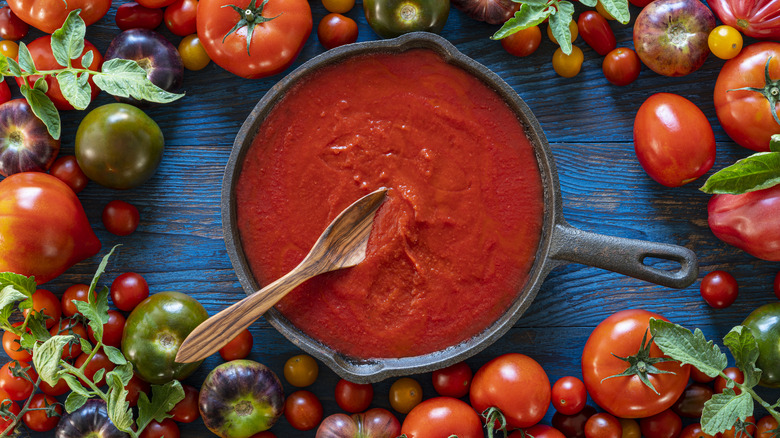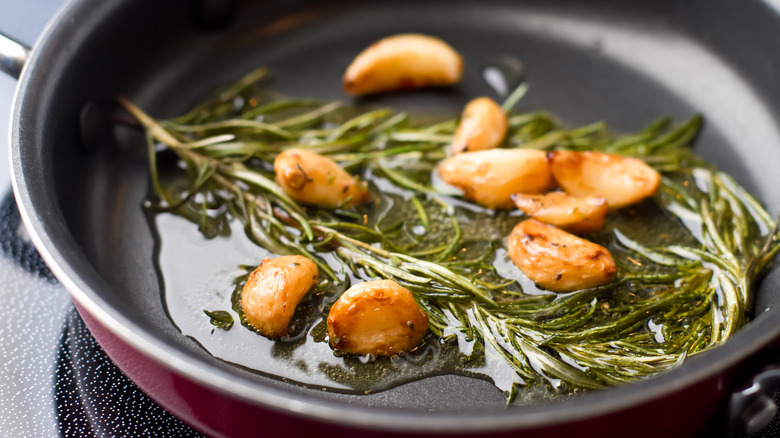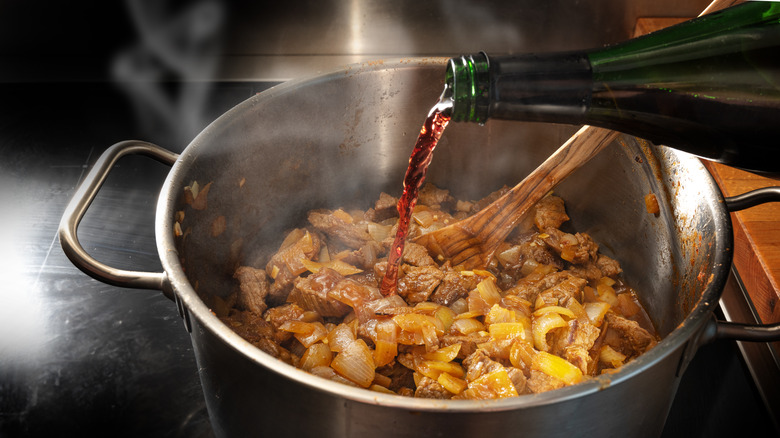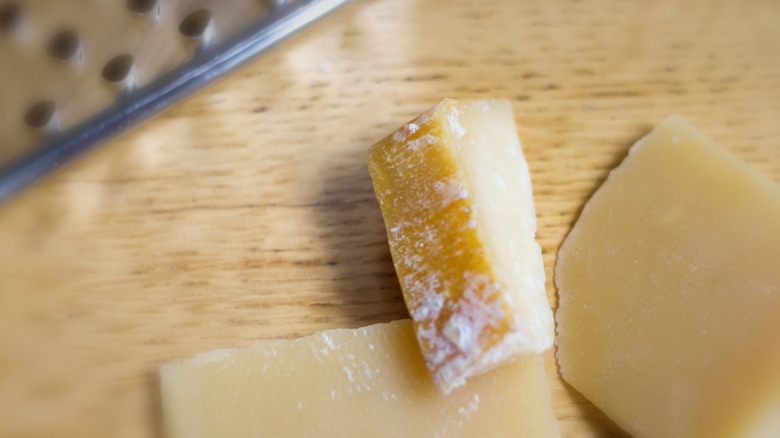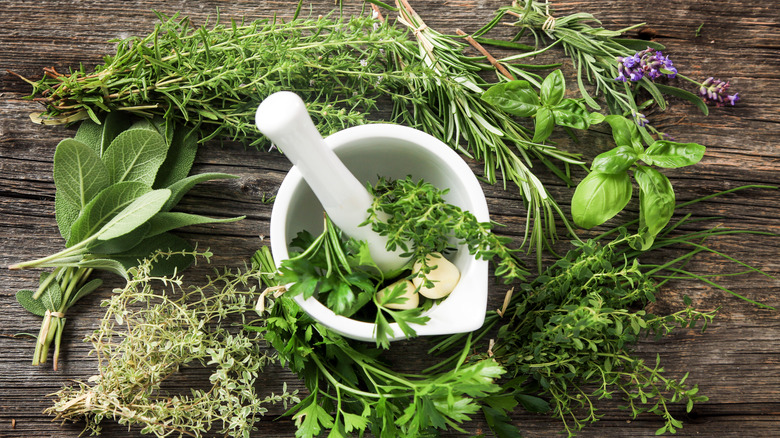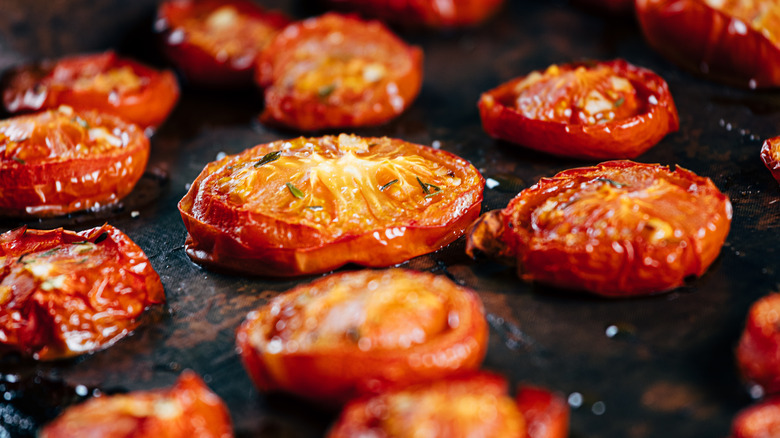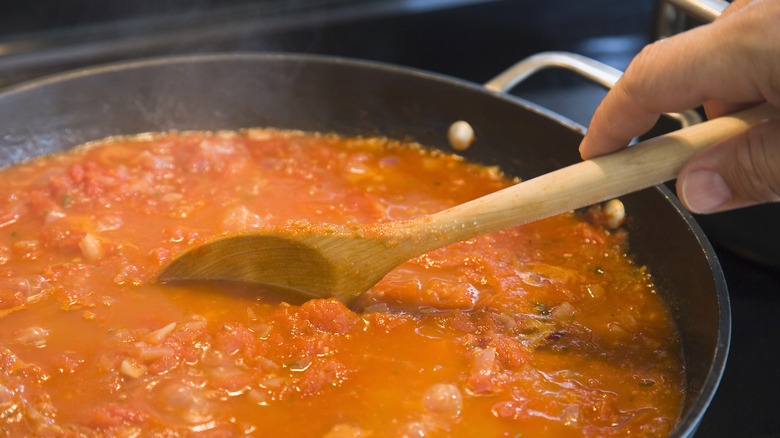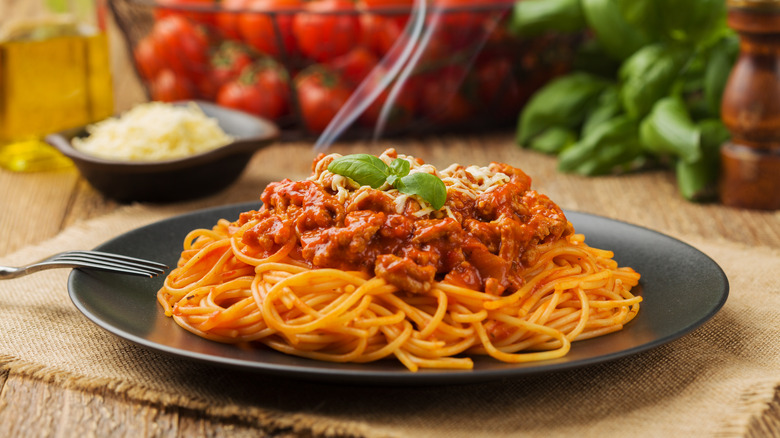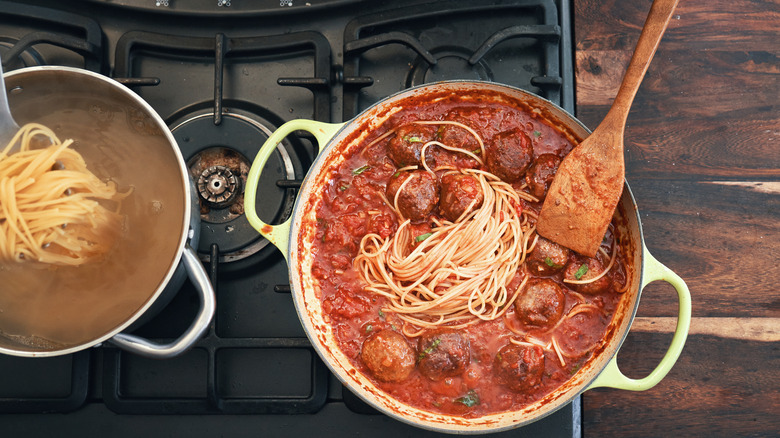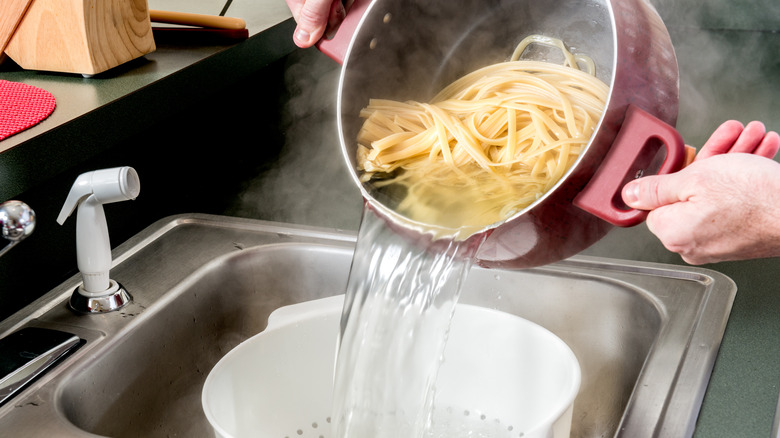10 Common Mistakes People Make With Tomato Sauce
Whether you're making pizza, spaghetti, chicken parmesan, or countless other dishes, knowing how to make a good tomato sauce is essential. Despite its simplicity when it comes to ingredients, the flavors of tomato sauce are surprisingly nuanced. Tomato sauce can be sweet or tangy, plain or herbaceous, mild or spicy. The consistency of tomato sauce can also be thin and smooth or chunky and rustic. Some of these qualities may be more desirable than others, depending on the dish and the recipe, along with personal preferences.
During my time working in kitchens, I've noticed that there are a handful of common mistakes that people can make when cooking tomato sauce. Being more mindful of these missteps can help ensure better results. Because tomato sauce is the heart and soul of so many recipes, it's always a good idea to have a better understanding of what to avoid and how to consistently make your tomato sauce as delicious as possible.
1. Burning the garlic
Garlic burns very easily. Garlic's susceptibility to burning is mostly due to its low water content and its higher concentration of natural sugars like fructose. This particular combination means that garlic can caramelize exceptionally fast — you've probably witnessed a pan full of raw garlic in a saucepan go from a light golden color to dark brown in a matter of seconds. The fact that garlic tends to be minced makes it even easier to burn, since each little morsel is so thoroughly exposed to the heat. The bottom line: just about everything about garlic makes it prone to burning. Garlic becomes intensely bitter when it's burned, which will spoil the flavor of your tomato sauce.
The good news is that this mistake can be easily avoided. Step one: add onions to your saucepan and cook them first, before the garlic. The onions take longer to cook and they will also release extra moisture into the pan, which can help the garlic stay hydrated during the cooking process. Once the onions are translucent, add the garlic. At this point, lower the heat on your stove and saute the garlic and onions over low heat until the garlic is fragrant. You don't want the garlic too raw because it will be overpowering and pungent — you just want it gently cooked. It's important to be extra attentive at this stage, since the garlic's color can change very quickly. Once the garlic is golden, your sauce is ready for the next step.
2. Forgetting to deglaze the pan
Another common mistake people make is forgetting to deglaze the pan. For those who have yet to become deglazing pros, this is the process of pouring a liquid — typically wine or stock — into a hot pot or saucepan after searing or sauteing. The deglazing liquid bubbles and steams up on the bottom of the pan, loosening up the caramelized bits of food stuck to the bottom from cooking. When all of those little browned bits are deglazed and scraped up and stirred in, they can contribute massive flavor to your tomato sauce. It's best to deglaze after you've sauteed your onions and garlic, right before you add your tomato sauce.
The problem is that a lot of people completely skip deglazing, either because they forget to do it or simply aren't aware of how important it is. Rather than deglazing with wine or stock after sauteeing, they just immediately add tomatoes and continue cooking the sauce. By skipping the deglazing process, their sauce ends up missing out on a lot of extra flavor. Considering that deglazing the pan doesn't really require much time or effort, it's totally with it.
3. Not adding a parmesan rind
One of the best ways to finish a bowl of pasta is to freshly-grate some aged parmesan cheese on top. Salty and nutty, aged parmesan adds a cheesy richness to pasta that's very tasty. While many people sprinkle parmesan on top of their pasta, there's another lesser-known way to boost up the cheesiness without having to grate the cheese at all. And it's all thanks to a part of the parmesan wedge that's often totally neglected and discarded: the rind.
The rind is the hardened skin on the outermost layer of the cheese. Though technically edible, parmesan rinds are often too tough to chew. As a result, the rinds are often thrown away once the softer parts of the cheese wedge have been eaten. Which is unfortunate, because these forsaken parmesan rinds are actually secret gifts with delicious jackpots just waiting to be liberated. The trick is knowing how to unlock their tasty potential.
The goods news is that using parmesan rinds couldn't be any easier. Simply add the whole rind directly to the tomato sauce towards the end of cooking and stir it around every few minutes. The rind should simmer in the sauce for anywhere between 20 to 30 minutes. Don't worry: your tomato sauce won't get gooey; the rind will get soft, but it won't fully melt. As the rind simmers, it will release its cheesy flavor, giving the sauce a delicious complexity. Rinds can also be used to flavor any other sauces, soups, and stews.
4. Adding fresh herbs too early
Fresh herbs can add a lot of vibrant flavor to tomato sauce and pasta dishes. The mistake that people tend to make is adding fresh herbs (or dried herbs) at the wrong time. In most cases, it's best to add fresh herbs, like oregano or thyme, to your tomato sauce at the very end of cooking. Adding these fresh herbs at the very end of the cooking process will help the herbs retain their distinctive freshness. If fresh herbs are added too early to the sauce and cooked for a long time, they'll wither and wilt down and their flavor will diminish from being overheated in the sauce.
Using dried herbs requires a polar opposite approach. With dried herbs, you want to add them early on so that they have time to rehydrate and bloom in the sauce. As the dried herbs rehydrate over time, they'll infuse the tomato sauce with more flavor. When you make tomato sauce, consider the type of herbs that you're using and then add them at the appropriate moment to maximize their flavor.
5. Not roasting the tomatoes
If you're working with raw tomatoes, there's an extra step that you can take to extract deeper flavors from them. Drizzle sliced tomatoes with olive oil and balsamic vinegar, then toss them with salt, pepper, and a little sugar. Roast them in the oven at 400 Fahrenheit for about 30 minutes until they're caramelized. Baking them with a touch of sugar speeds up the caramelization process, and the balsamic vinegar complements that sweetness with a hint of complex tanginess. These tomatoes are great to top salads with, but they're also wonderful to use as a base for tomato sauce.
Puree the roasted tomatoes to your desired consistency. For a thinner sauce, blend them longer until it's uniformly smooth. For a chunkier sauce, start out on pulse mode and give it only a few spins. Set the sauce aside, and then sautee your onions and garlic in a saucepan. After you've deglazed the pan, add in your roasted tomato sauce, then season and simmer to taste. You'll notice that tomato sauce made with roasted tomatoes is a tad sweeter and has a more concentrated flavor than tomato sauce made with raw tomatoes.
6. Cooking time
It may seem obvious, but occasionally not enough attention is paid to the amount of time that tomato sauce should be cooked for. This can lead to undesired outcomes in terms of flavor and texture.
The first step is deciding what kind of texture you'd like the tomato sauce to have. If you want it to be on the thinner side, then it's best to not simmer it very long. Keeping the tomato sauce's cooking time to a minimum will allow it to retain its moisture, which will keep the sauce thin. This faster approach will also produce a tangier sauce since the tomatoes won't have enough time to fully sweeten.
If you're aiming for a thicker sauce, then simmering it without a lid for a longer period of time would be a wise choice. The longer the sauce simmers, the more moisture will evaporate, which thickens the sauce over time. Another factor worth considering is how sweet you'd like the sauce to be. As the tomato sauce simmers and reduces, the flavor will become sweeter and more concentrated. In short, it's important to think about the results you're trying to achieve with your tomato sauce and adjust the cooking time as necessary.
7. Using pre-made jars of spaghetti sauce
As tempting as it is to use premade jars of spaghetti sauce, this is often a mistake. Many brands of premade spaghetti sauce are often too salty or too sweet and have an overly-processed flavor. Instead of buying jars of spaghetti sauce, try buying plain canned tomatoes instead. Not only will plain canned tomatoes give you total control over the seasonings and flavor of your sauce, but they're often also much cheaper than jars of premade spaghetti sauce too.
Canned tomatoes typically come in three varieties: whole, diced, and crushed. The whole tomatoes are stored in tomato juice and left completely whole and usually peeled. Whole canned tomatoes are a great choice when you want a more rustic sauce that's chunky. You can either give them a quick pulse in the blender or break them apart with a spoon directly in your saucepan. Diced tomatoes are often cut into large cubes that usually need to be blended down a little bit more. Cans of crushed tomatoes are the smoothest option and are basically pureed. Cans of crushed tomatoes are a good option for a more traditional spaghetti sauce.
The next time you want to make spaghetti, try making your sauce with canned tomatoes. Cook diced onions and minced fresh garlic in a mix of olive oil and butter over low heat with dried oregano, salt, and pepper. Deglaze the pan with a splash of red wine, then add your canned tomato sauce. Simmer and season to taste.
8. Not finishing your pasta in the sauce
Of course, tomato sauce is often made for pasta. One common mistake that people make is completely cooking the pasta in a separate pot of water and then spooning the tomato sauce over the pasta afterward. While there's nothing necessarily wrong with this, there is another way to cook your pasta that can drastically improve it.
Cook your pasta al dente (which means that noodles should be boiled but still retain some firmness). When the pasta is al dente, add it directly into your tomato sauce and keep the burner on over low heat. As the sauce gently simmers, keep stirring the pasta and let it cook. Because the pasta was only partially cooked in a separate pot before this, the pasta will finish cooking and soften up some more in the tomato sauce. Finishing your pasta in the saucepan allows your pasta to soak up tomato sauce during the cooking process, which gives the noodles a lot more flavor.
9. Not adding butter
Butter is often used to begin making a sauce to saute vegetables such as onions and garlic. But you should also consider using butter not only as a way to start a tomato sauce but also as a way of finishing it.
Butter has a creaminess to it that helps ease the sharpness and acidity of tomato sauce. It also helps emulsify the sauce and gives it a luxuriously velvety texture that has a delicious consistency. Note: don't melt the butter before you add it to the tomato sauce. Add a couple of cold, solid butter chunks straight from the fridge at the very end of cooking, and then let them melt directly into the sauce. The burner should be off (or at a very low heat level) at this point and the residual heat in the sauce should be warm enough to melt the butter. Give it time to melt and keep stirring until the butter has seamlessly infused into the tomato sauce.
10. Not adding pasta water
Many people are taught to dump all of their pasta water down the sink drain through a colander. This is a bad habit, because that discarded pasta water contains something that can dramatically improve your tomato sauce: starch. As pasta boils, its starches are released into the water. That's why pasta water looks so cloudy after cooking. It's also why pasta water becomes more viscous as it cooks.
Before you strain your pasta, be sure to scoop out a cup of starchy pasta water and set it aside. Then add a little bit of that pasta water to your sauce and gently stir it in over low heat. The starch from the water will infuse into your tomato sauce, which will help the sauce better bind to your pasta. Have you ever seen sauce have some serious trouble sticking to pasta? Tragic, isn't it? Adding pasta water to your tomato sauce can entirely prevent that blunder from happening, since the starch helps unify the sauce to the noodles.
